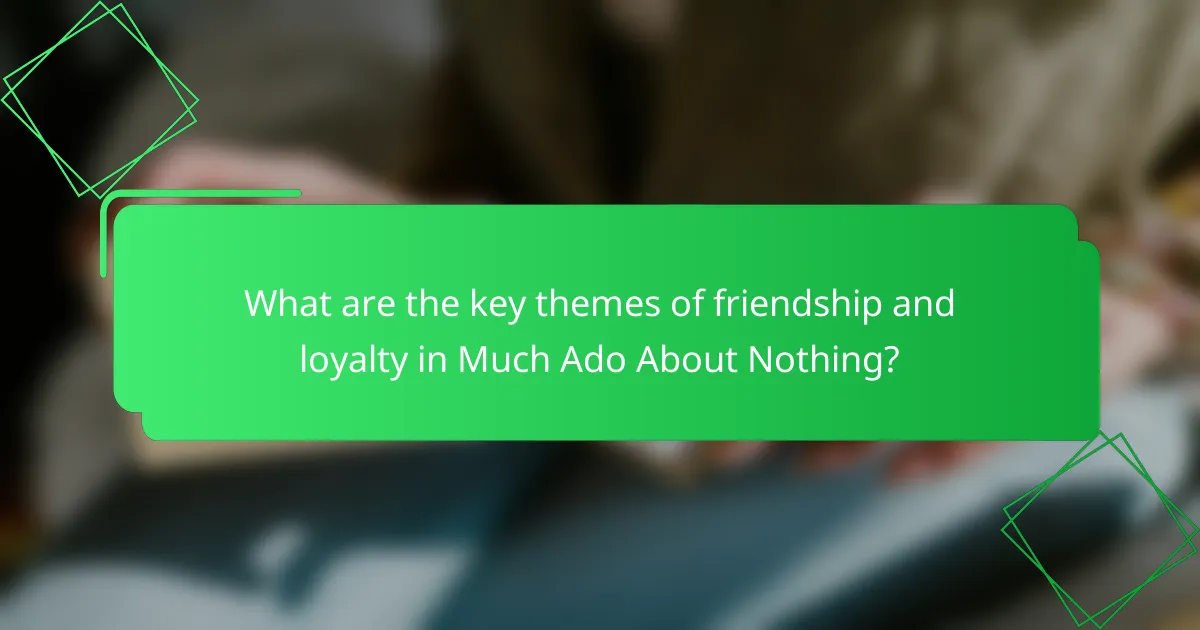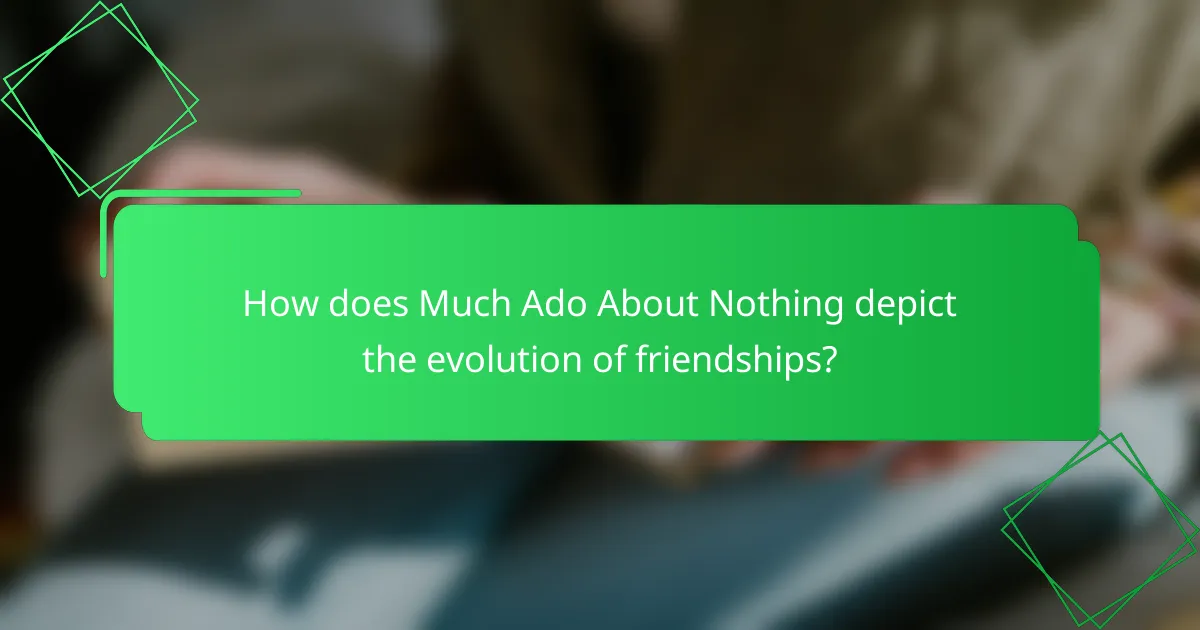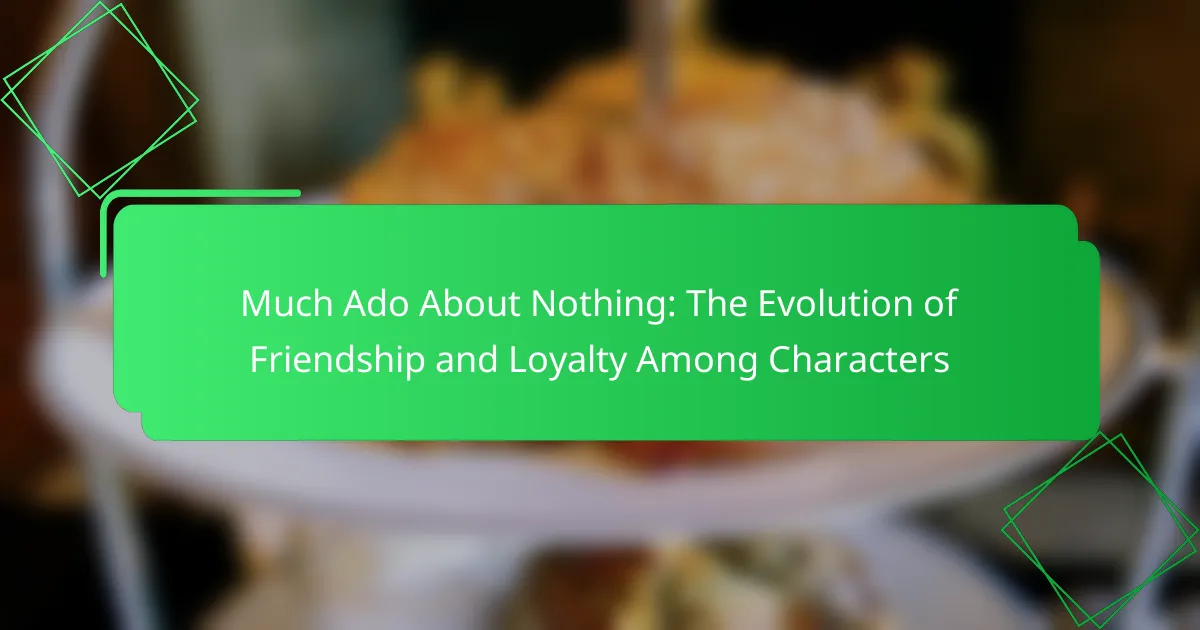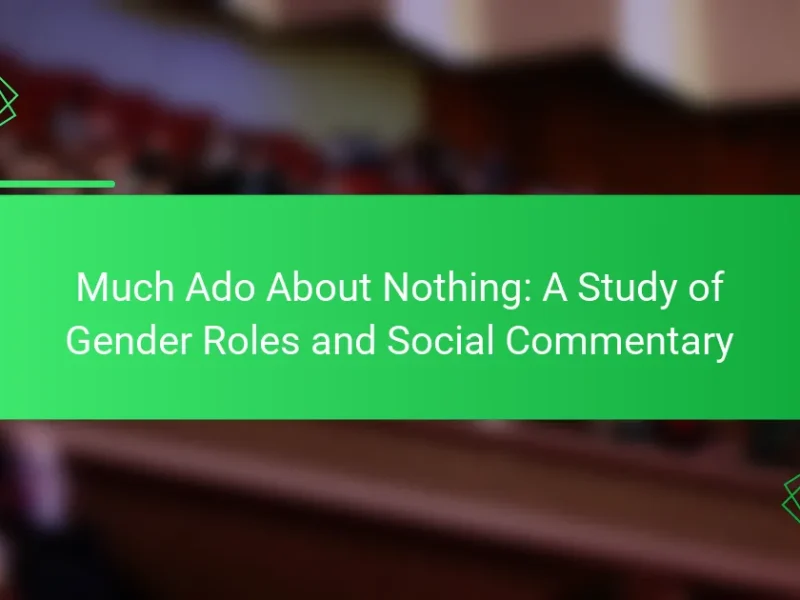
What are the key themes of friendship and loyalty in Much Ado About Nothing?
The key themes of friendship and loyalty in Much Ado About Nothing are central to character relationships and plot development. Friendship is exemplified through the bond between Beatrice and Benedick. Their witty exchanges reveal a deep mutual respect and affection. Loyalty is portrayed through characters like Claudio, who struggles with trust and betrayal. His loyalty to societal expectations leads to conflict with his love for Hero. The theme of loyalty is also evident in the unwavering support of friends during misunderstandings. For example, the loyalty of the characters who help to clear Hero’s name showcases the importance of friendship in overcoming adversity. These themes intertwine, illustrating how friendship can both strengthen and challenge loyalty among characters.
How do the relationships between characters illustrate these themes?
The relationships between characters in “Much Ado About Nothing” illustrate themes of friendship and loyalty through various interactions and conflicts. For instance, the bond between Benedick and Claudio highlights loyalty, as Benedick initially supports Claudio’s decisions. However, their friendship is tested when Benedick questions Claudio’s treatment of Hero. This shift emphasizes how loyalty can be challenged by moral dilemmas.
Additionally, the relationship between Beatrice and Benedick showcases the evolution of friendship into deeper loyalty. Their witty banter evolves into mutual respect and love, illustrating how friendships can transform through honesty and vulnerability. The playful rivalry eventually leads to a strong alliance, reinforcing the theme of loyalty in relationships.
Moreover, the betrayal of Hero by Claudio underlines the fragility of loyalty among friends. Claudio’s quick judgment reflects how misunderstandings can damage relationships. This act of betrayal serves as a catalyst for character development, ultimately leading to reconciliation and restored friendships.
Overall, the relationships among the characters serve as a vehicle to explore the complexities of friendship and loyalty, demonstrating that these themes are integral to the narrative’s progression.
What are the defining characteristics of friendship among the main characters?
The defining characteristics of friendship among the main characters include loyalty, trust, and mutual support. Loyalty is evident in the unwavering commitment characters show to one another, especially during conflicts. Trust is established through open communication and shared experiences, reinforcing their bonds. Mutual support is demonstrated when characters assist each other in times of need, showcasing their dedication to one another’s well-being. These characteristics are pivotal in navigating misunderstandings and fostering reconciliation throughout the narrative.
How is loyalty portrayed through the actions of key characters?
Loyalty is portrayed through the actions of key characters by their steadfast support and commitment to one another. For instance, Benedick’s unwavering dedication to Beatrice is evident when he challenges Claudio over the mistreatment of her cousin. This act exemplifies loyalty as Benedick prioritizes his relationship with Beatrice over social conventions. Similarly, Claudio’s initial betrayal of Hero contrasts with the theme of loyalty, highlighting the consequences of misplaced trust. Hero’s forgiveness of Claudio later demonstrates her loyalty to love, despite his wrongdoings. Additionally, the friendship between Beatrice and Hero showcases loyalty through their mutual support in times of distress. Their bond is strengthened by shared experiences and unwavering trust. Overall, the actions of these characters reflect loyalty as a central theme in the narrative, emphasizing the importance of trust and support in relationships.
Why are friendship and loyalty significant to the plot development?
Friendship and loyalty are significant to plot development as they drive character motivations and conflicts. In “Much Ado About Nothing,” these themes shape relationships and influence decisions. For instance, the loyalty between characters like Benedick and Claudio affects their actions and reactions throughout the narrative. The betrayal of loyalty leads to pivotal moments, such as misunderstandings and reconciliations. Friendship fosters alliances that propel the story forward, creating tension and resolution. Ultimately, these elements contribute to character growth and thematic depth, making them essential to the overall narrative structure.
How do misunderstandings affect friendships in the story?
Misunderstandings significantly strain friendships in “Much Ado About Nothing.” Characters often misinterpret intentions and words. This leads to conflicts and rifts between friends. For example, Claudio’s belief that Hero is unfaithful causes him to publicly shame her. This act damages their relationship and affects their friends. Additionally, the deception surrounding Beatrice and Benedick creates confusion and mistrust. Ultimately, these misunderstandings highlight the fragility of friendships. They show how easily trust can be broken through miscommunication.
What role does loyalty play in the resolution of conflicts?
Loyalty plays a crucial role in the resolution of conflicts by fostering trust and commitment among individuals. In “Much Ado About Nothing,” characters demonstrate loyalty that helps to bridge misunderstandings. For example, the loyalty between Benedick and Beatrice ultimately leads to their reconciliation. Similarly, Claudio’s loyalty to his friends influences his decisions and actions throughout the play. This loyalty can motivate individuals to seek resolution rather than escalation. Historical contexts show that loyalty often acts as a catalyst for forgiveness and understanding in relationships. In this narrative, loyalty not only strengthens bonds but also aids in overcoming adversities.

How does Much Ado About Nothing depict the evolution of friendships?
Much Ado About Nothing depicts the evolution of friendships through the changing dynamics among its characters. Initially, friendships appear strong and loyal, particularly between Benedick and Claudio. However, misunderstandings and deception challenge these bonds. Claudio’s trust in Don John leads to a betrayal that strains his friendship with Benedick.
As the plot unfolds, characters confront their conflicts and misunderstandings. Benedick’s loyalty to Claudio is tested, yet he ultimately chooses to reconcile. The resolution of misunderstandings illustrates the growth of friendships. By the end, friendships are restored, showcasing the resilience of these relationships.
This evolution reflects the complexities of human connections and the impact of trust and communication. The characters’ journeys emphasize that true friendship can endure trials and emerge stronger.
What events trigger changes in the friendships among characters?
Betrayal, misunderstandings, and reconciliations trigger changes in friendships among characters. In “Much Ado About Nothing,” Claudio’s public shaming of Hero strains their relationship. This act of betrayal leads to Hero’s apparent death and a temporary rift between friends. Additionally, misunderstandings, such as the deception involving Beatrice and Benedick, alter their dynamics. The eventual reconciliations, particularly through the reveal of Hero’s innocence, restore and strengthen friendships. These events highlight the fragility and complexity of relationships in the play.
How do external influences shape the dynamics of friendship?
External influences significantly shape the dynamics of friendship. These influences include social environment, cultural norms, and life experiences. Social environment affects who individuals meet and interact with. Cultural norms dictate acceptable behaviors and expectations within friendships. Life experiences, such as shared challenges or successes, can strengthen or weaken bonds. For instance, friendships may evolve during significant life transitions like moving or changing jobs. Research indicates that friends often reflect each other’s values and behaviors, influenced by their surroundings. Studies show that friendships can change due to peer pressure or societal expectations. Thus, external factors play a crucial role in the formation and maintenance of friendships.
What pivotal moments lead to the strengthening or weakening of bonds?
Pivotal moments that lead to the strengthening or weakening of bonds include betrayal, misunderstandings, and acts of loyalty. Betrayal can create significant rifts in relationships. For example, in “Much Ado About Nothing,” Don John’s deception weakens the bond between Claudio and Hero. Misunderstandings can also strain relationships, as seen when Claudio wrongly accuses Hero of infidelity. Conversely, acts of loyalty can fortify bonds. The unwavering support of friends, like Benedick defending Beatrice, helps strengthen their connection. These moments illustrate how trust and communication are essential in maintaining relationships.
How do different characters exemplify varying approaches to friendship?
Different characters in “Much Ado About Nothing” exemplify varying approaches to friendship through their actions and relationships. For instance, Benedick and Claudio demonstrate contrasting views on loyalty and trust. Benedick values honesty and supports his friends openly, while Claudio shows jealousy and betrayal. Their interactions highlight the complexities of male friendship.
Beatrice and Hero also illustrate different aspects of female friendship. Beatrice is fiercely loyal and protective of Hero, showcasing a deep bond. In contrast, Hero’s more passive approach reflects societal expectations.
Moreover, the relationships between characters like Don Pedro and Claudio reveal a mentor-mentee dynamic. Don Pedro’s guidance emphasizes the importance of loyalty in friendship, while Claudio’s actions question trustworthiness.
These character dynamics underscore the theme of friendship’s evolution throughout the play, revealing how personal values shape relationships.
What are the contrasting friendship models presented by characters like Beatrice and Benedick?
Beatrice and Benedick present contrasting friendship models characterized by wit and emotional depth. Beatrice embodies a friendship that values independence and sharp banter. She often uses humor to mask her vulnerability. Benedick, on the other hand, represents a friendship rooted in loyalty and emotional connection. His character evolves from cynicism to genuine affection for Beatrice. Their interactions highlight the tension between playful rivalry and sincere companionship. This dynamic reflects the complexity of relationships in “Much Ado About Nothing.” Their differing approaches to friendship ultimately reveal the balance between humor and emotional intimacy.
How does Claudio’s friendship differ from that of other characters?
Claudio’s friendship differs from that of other characters in its conditional nature. His loyalty is heavily influenced by external validation and societal expectations. Unlike Benedick and Beatrice, who share a more genuine and honest connection, Claudio’s bond with others is often superficial. He quickly doubts his friend Don Pedro’s judgment regarding Hero. This leads him to publicly shame Hero without seeking the truth first. In contrast, characters like Benedick show loyalty through support and understanding. Claudio’s friendships lack depth and are fragile, relying on appearances rather than trust.

What lessons can be learned about loyalty from the characters in Much Ado About Nothing?
Loyalty in Much Ado About Nothing teaches the importance of trust and communication. Characters like Claudio and Benedick illustrate how loyalty can be tested by misunderstandings. Claudio’s quick judgment of Hero shows that loyalty can falter without clear communication. Benedick’s eventual support of Beatrice highlights that true loyalty involves standing by loved ones. Additionally, the deception surrounding the characters reveals that loyalty must be based on truth, not appearances. The resolution of conflicts emphasizes that loyalty can be restored through honesty and reconciliation. Overall, the play demonstrates that loyalty requires effort and understanding to thrive.
How do the outcomes of loyalty and betrayal impact character relationships?
Loyalty and betrayal significantly impact character relationships by shaping trust and emotional bonds. When a character demonstrates loyalty, it fosters stronger connections and mutual respect. This can lead to deeper friendships and alliances, as seen in the supportive interactions between characters like Benedick and Beatrice. Conversely, betrayal undermines trust and can fracture relationships irreparably. For instance, Claudio’s betrayal of Hero leads to public shame and isolation for her. The outcomes of these actions create a ripple effect, influencing how characters interact with one another moving forward. Betrayal often results in conflict and resentment, while loyalty encourages reconciliation and unity. The dynamics of these outcomes are crucial in understanding the evolution of friendships within the narrative.
What consequences do characters face for their loyalty or disloyalty?
Characters in “Much Ado About Nothing” face significant consequences for their loyalty or disloyalty. Loyal characters often experience rewards such as strengthened relationships and social standing. For example, Benedick and Beatrice’s loyalty to each other leads to their eventual union. In contrast, disloyal characters face isolation and mistrust. Claudio’s disloyalty towards Hero results in public shame and a damaged reputation. The consequences highlight the importance of loyalty in maintaining friendships. Disloyalty disrupts social harmony and leads to conflict among characters. Ultimately, loyalty fosters deeper connections, while disloyalty brings about estrangement and regret.
How does loyalty influence the character development of key figures?
Loyalty significantly influences the character development of key figures in “Much Ado About Nothing.” Characters demonstrate growth through their commitments and allegiances. For example, Claudio’s loyalty to societal expectations leads to his initial betrayal of Hero. This act catalyzes his character’s evolution as he grapples with guilt and seeks redemption. Conversely, Beatrice’s loyalty to her cousin Hero motivates her to confront Claudio, showcasing her strength and moral integrity. Additionally, Benedick’s loyalty to Beatrice transforms him from a carefree bachelor to a committed partner. These dynamics illustrate how loyalty shapes relationships and drives character arcs throughout the narrative.
What practical insights can we gain from the friendships and loyalties depicted?
Friendships and loyalties in “Much Ado About Nothing” reveal the significance of trust and communication. Trust is foundational in relationships, as seen between Benedick and Beatrice. Their witty banter transforms into deep affection, illustrating the importance of understanding in friendships. Communication is vital; misunderstandings lead to conflict, as shown in Claudio’s misjudgment of Hero. Loyalty can be tested by external influences, evident when Don John manipulates relationships. The play demonstrates that true loyalty withstands challenges, as seen when friends unite against deception. These insights emphasize the need for open dialogue and unwavering support in maintaining strong relationships.
How can the themes of friendship and loyalty be applied to real-life relationships?
Friendship and loyalty are essential themes that enhance real-life relationships. They foster trust and emotional support between individuals. When friends demonstrate loyalty, they create a safe environment for open communication. This trust encourages vulnerability, allowing deeper connections to form. Studies show that loyal friendships contribute to improved mental health and overall well-being. For instance, research by the American Psychological Association indicates that strong social support networks reduce stress and anxiety. Loyalty in friendships also promotes resilience during challenging times. Friends who stand by each other can navigate conflicts more effectively. Thus, applying these themes leads to healthier and more fulfilling relationships.
Much Ado About Nothing serves as a critical exploration of the themes of friendship and loyalty among its characters. The article delves into how these themes influence character relationships and plot development, highlighting key interactions, misunderstandings, and acts of loyalty that shape the narrative. It examines the defining characteristics of friendship, the implications of loyalty, and the consequences of betrayal, providing insights into the evolution of friendships and the dynamics that affect them. Through character analysis, the article illustrates the complexities of loyalty and the lessons learned from these relationships.


